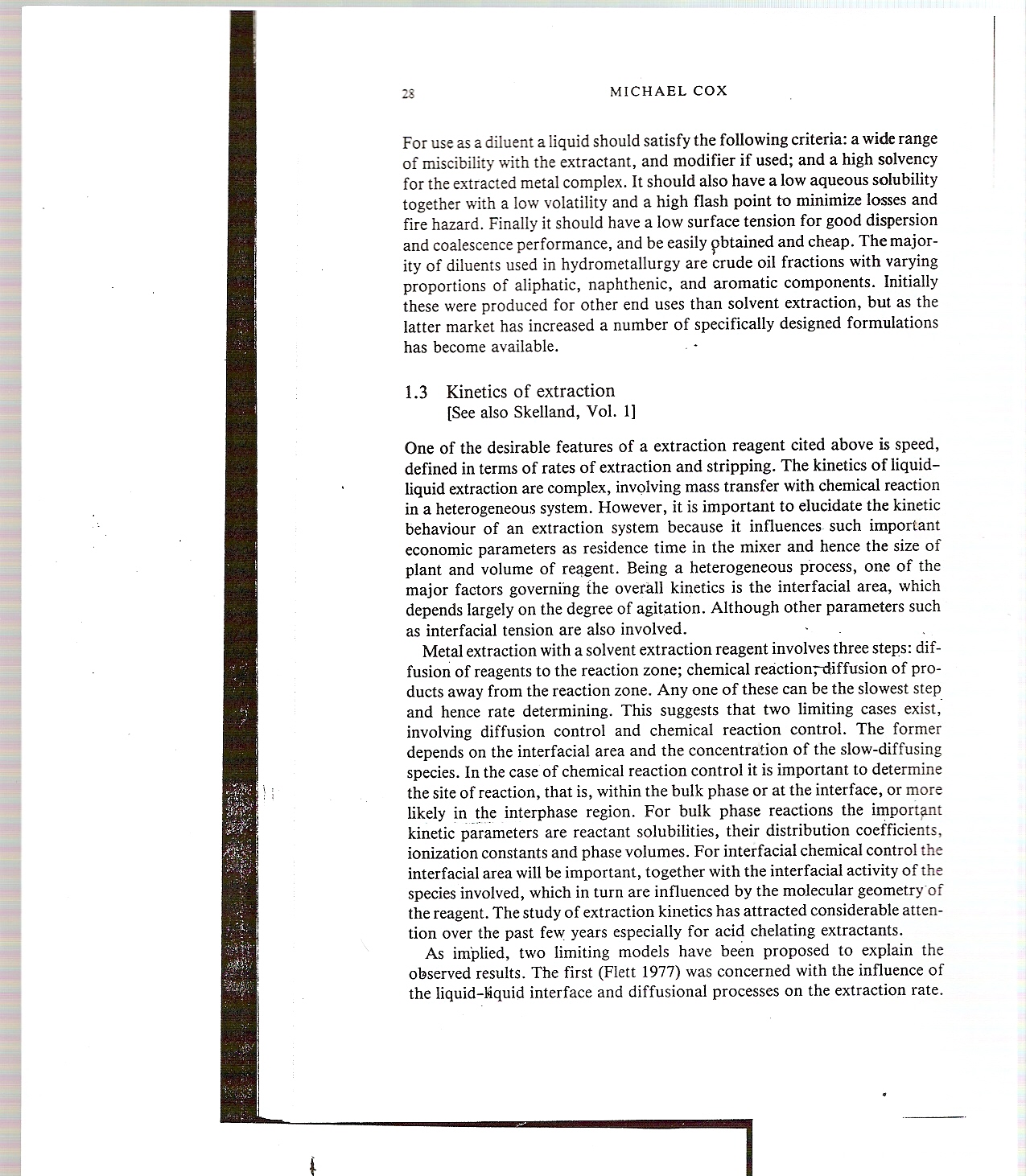scan0041 2

28
MICHAEL COX
For use as a diluent a liąuid should satisfy the following criteria: a wide rangę of miscibility with the extractant, and modifier if used; and a high solvency for the extracted metal complex. It should also have a Iow aqueous solubility together with a Iow volatility and a high flash point to minimize losses and fire hazard. Finally it should have a Iow surface tension for good dispersion and coalescence performance, and be easily pbtained and cheap. Themajor-ity of diluents used in hydrometallurgy are crude oil fractions with varying proportions of aliphatic, naphthenic, and aromatic components. Initially these were produced for other end uses than solvent extraction, but as the latter market has increased a number of specifically designed formulations has become available.
1.3 Kinetics of extraction [See also SkeUand, Vol. 1]
One of the desirable features of a extraction reagent cited above is speed, defined in terms of rates of extraction and stripping. The kinetics of liquid-liąuid extraction are complex, invęlving mass transfer with Chemical reaction in a heterogeneous system. However, it is important to elucidate the kinetic behaviour of an extraction system because it influences such important economic parameters as residence time in the mixer and hence the size of plant and volume of reagent. Being a heterogeneous process, one of the major factors goveming the overall kinetics is the interfacial area, which depends largely on the degree of agitation. Although other parameters such as interfacial tension are also involved.
Metal extraction with a solvent extraction reagent involves three steps: dif-fusion of reagents to the reaction zonę; Chemical reactionrdiffusion of Products away from the reaction zonę. Any one of these can be the slowest step and hence ratę determining. This suggests that two limiting cases exist, involving diffusion control and Chemical reaction control. The former depends on the interfacial area and the concentration of the slow-diffusing species. In the case of Chemical reaction control it is important to determine the site of reaction, that is, within the bulk phase or at the interface, or morę likely in the interphase region. For bulk phase reactions the important kinetic parameters are reactant solubilities, their distribution coefficients, ionization constants and phase volumes. For interfacial Chemical control the interfacial area will be important, together with the interfacial activity of the species involved, which in turn are influenced by the molecular geometry of the reagent. The study of extraction kinetics has attracted considerable atten-tion over the past few years especially for acid chelating extractants.
As implied, two limiting models have been proposed to explain the observed results. The first (Flett 1977) was concerned with the influence of the liquid-tóquid interface and diffusional processes on the extraction ratę.
Wyszukiwarka
Podobne podstrony:
scan0031 4 18 MICHAEL COX 1.2.3 Solvating extractants In generał a soWating extractant tends to be r
scan0023 3 10 MICHAEL COX have an appreciable aqueous solubility, which can, under operating condi-t
scan0027 3 14 MICHAEL COX (p - n) R4N* Y" + MXjT«- ^ (R4N)p.łł(MXp) + (p-n)Y * (1.12) An altern
scan0039 2 26 MICHAEL COX di-2-ethylhexylphosphoric acid. The presence of a third phase causes con-s
scan0043 2 30 MICHAEL COX hydrodynamic parameters but are difficult to set up and operate. Trouve et
FLINT MINING OF CENTRAL EUROPE 41 rounded; the other one is transversely “cut”, for use as a hammer
NamePractice B For use with pages 452-459 Solve the equation. Check your solution. >1. + 3 = 12
Measurements and Patterns pattern. For the patterns on the following pages, only half of the front&n
Social PsychologySocial psychologists study a wide rangę of topics within broader categories, such a
Untitled 2 (3) ■ Here just a smali selec-tion from our wide rangę of exciting projects Gorgeous ta
CSG247 236 Complete Spanish Grammar The following is a selected list of verbs that take a person as
scan0035 2 MICHAEL COX metal-extractant bonds are strongj morę specific reagents are required. As th
Chapter 6: Guideiines for Writing SAS Codę for Use with SAS University Edition SAS University Editio
bsp proj gal Slider OptionsUse GalleryFeatured Gallery ^ Select which gallery to u
© In groups, prepare a job advert for one of the part-time jobs in the box. Use as many words and ph
scan0017 3 4 MICHAEL COX with extensive recycling, some impurities do build up in the process stream
więcej podobnych podstron